|
|
|
|
|
Oil On
Canvas, Real Flavor of Old Masters
|
|

|
ARTWORKS
INDEX
A B C D E F G H I J K L M N O P Q R S T U V W X Y Z |
ARTISTS
INDEX
A B C D E F G H I J K L M N O P Q R S T U V W X Y Z |
|
|
| | |
|
|
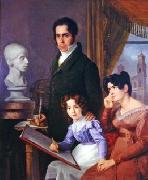 |
Domingos Antonio de Sequeira -- Click Here
|
|
painted Familia Barros in19th century
|
|
 |
De Scott Evans -- Click Here
|
|
1847-1898
was an American artist who worked in Indiana, Ohio and New York. He was known for portraits, still lifes, landscapes and other genres.
Born in Boston, Indiana to David S. and Nancy A. (Davenport) Evans. His father was a physician. Evans changed his signature to D. Scott Evans and later to De Scott Evans. He also signed paintings with the names David Scott, S. S. David, and Stanley S. David. He attended Miami University's preparatory school in the 1860s, studying with professor Adrian Beaugureau at Miami and later in Cincinnati.
In 1873, he became head of the art department at Mount Union College and after several terms there, he moved to Cleveland to teach and to paint. From Cleveland, he moved to New York. He died along with 500 other passengers and crew, including his daughters when the French steamer La Bourgogne was rammed by a sailing ship in July 1898.
Though he died at sea, there is a marker for him and his daughters in the Oxford Cemetery in Oxford, Ohio. |
|
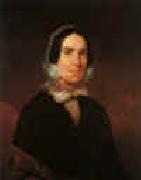 |
David Hunter Strother -- Click Here
|
|
1816-1888
Strother was born in Martinsburg, Virginia (now West Virginia). He studied drawing under Pietro Aneora in Philadelphia, Pennsylvania from 1829 to 1836 when he became a student of Samuel F. B. Morse in New York. Strother was an artist for The Crayon, the leading art journal of the United States at the time, and a frequent contributor to Harper's Monthly. Most of his early work was comprised of landscapes and other outdoor scenes. His art pertained mostly to Virginia and the Southern United States. Prior to the American Civil War, his art was published in books titled The Blackwater Chronicle (1853) and Virginia Illustrated (1857).
During the Civil War, Strother was commissioned by the U.S. Army and assigned as a topographer due to his detailed knowledge of the Shenandoah Valley. During this time, Strother recorded his experiences in the war which he would later publish in Harper's Monthly as "Personal Recollections of the War." His accounts are considered to be unique and are highly praised for their objective viewpoint. He was involved in 30 battles, though never wounded, and was brevetted brigadier general by the War's end.
After the war, topics of his pieces covered a wider range of subjects. Strother began to make works which commented on politics and race relations. He even sketched a portrait of Chief Sitting Bull. Some of his drawings were merely of individuals and groups going about their daily lives.
Strother ended his career as an artist when he was appointed by President Rutherford B. Hayes to be the General Consul to Mexico City in 1879. He returned to West Virginia in 1885 and died there three years later. The New York Times published an obituary in which it is stated that his name was a household one during his career. Strother is buried in Green Hill Cemetery in Martinsburg, West Virginia. |
|
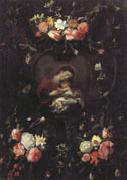 |
Daniel Seghers -- Click Here
|
|
Flemish Baroque Era Painter, 1590-1661
was a Jesuit brother and Flemish Baroque painter who specialized in flower still lifes, and is particularly well-known for his contributions to the genre of "flower garland" painting. His paintings were collected enthusiastically by courtly patrons and he had numerous imitators. Born in Antwerp, Seghers moved to the Dutch Republic around 1601, following the death of his father Pierre and the conversion of his mother to Calvinism.[1] The young artist returned to Antwerp by 1611, where he was enrolled in the guild of St. Luke as a student of Jan Brueghel the Elder.After re-converting back to Catholicism, in 1614 he became a noviciate in the Jesuit order in MechelenUntil 1625 Seghers continued to work as a painter in Antwerp, as well as a stay in Brussels in 1621Sources differ regarding his status in the Jesuit order: some claim that he was ordained a priest in 1625,while other argue that he remained a lay brother. |
|
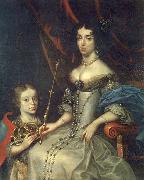 |
Daniel Schultz the Younger -- Click Here
|
|
painted Portrait of Maria Kazimiera with her son Jakub Ludwik in 1674 |
|
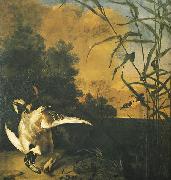 |
Daniel Schultz -- Click Here
|
|
(1615 - 1683) was a famous painter of the Baroque era, born and active in the Polish - Lithuanian Commonwealth. He painted many Polish and Lithuanian nobles, members of the royal family, local Patricians, such as the astronomer Johannes Hevelius, and animals. |
|
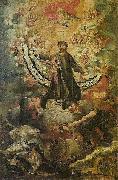 |
Cuzco School -- Click Here
|
|
The Cuzco School (Escuela Cuzqueña) was a Roman Catholic artistic tradition based in Cusco, Peru (the former capital of the Inca Empire) during the Colonial period, in the 16th, 17th and 18th centuries. It was not limited to Cuzco only, but spread to other cities in the Andes, as well as to present day Bolivia and Ecuador.
|
|
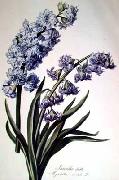 |
Cornelis van Spaendonck Prints -- Click Here
|
|
Dutch 1756-1840
Cornelis van Spaendonck (7 December 1756 - 22 December 1839) was a Dutch painter who was a native of Tilburg. Spaendonck initially worked under artist Guillaume-Jacques Herreyns (1743-1827) in Antwerp, and in 1773 moved to Paris to study and work with his brother, floral painter G??rard van Spaendonck (1746-1822). From 1785 to 1800, Cornelis van Spaendonck was head of the porcelain works at S??vres. Due to difficulties encountered as an administrator, he was relieved of his directorship in 1800, but remained at S??vres as a designer and artist until 1808.
In 1789 Spaendonck became a member of the Acad??mie des Beaux Arts. He painted throughout his lifetime, and displayed his works at the Salons of Paris until 1833. Most of Spaendonck's works were created with oils and gouache, and he is remembered for his lush still-lifes of flowers. Among his paintings were subjects such as De Fleurs Et Fruits, Vase De Fleurs, Bouquet De Different Fleurs, Fleurs Du Jardin, Corbeille Fleurs, et al. At his death in 1840 there were 29 paintings in his studio, which were auctioned soon afterwards. |
|
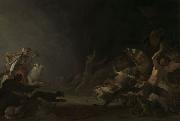 |
Cornelis Saftleven -- Click Here
|
|
(c. 1607, Gorinchem - 1 June 1681, Rotterdam) was a Dutch Golden Age painter
He was born into a family of artists, and learned to paint from his father Herman, along with his brothers Abraham and Herman Saftleven the Younger. He lived for a time in Utrecht with his brother.
Saftleven's subject matter covered various subjects, including genre works, portraits, beach scenes, and biblical and mythological themes. Some consider his images of Hell to be his most individual contribution to Dutch painting
|
|
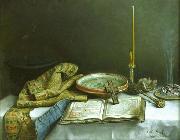 |
Constantin Daniel Stahi -- Click Here
|
|
(November 14, 1844 - June 18, 1920) was a Romanian painter and gravure artist.
In 1862 he entered the National School of Fine Arts from Iaşi where he was taught by Gheorghe Panaiteanu Bardasare and Gheorghe Şiller. He continued his artistic education in Munich where, for seven years, he studied painting, metal gravure and xylography.
He painted still life paintings representing small objects that were surrounding him, such as old books, newspapers, religious items, chairs, shoes, plates and especially fruits. Also, he painted many portraits of famous people of his time (for example Gheorghe Asachi, painted in 1881). Many others of his paintings take inspiration from the simple life in the countryside in idyllic compositions and by painting peasants having as models people living in Bavaria and Moldova regions.
Beside his artistic career, he was a professor and, later on, the headmaster of the National School of Fine Arts in Iaşi between 1892 and 1902, following Gheorghe Panaiteanu Bardasare.
He died in his house on Bărboi street in Iaşi on June 18, 1920 and was interred at Eternitatea Cemetery.
|
|
 |
Colman Samuel -- Click Here
|
|
American Hudson River School Painter , 1832-1920
was an American painter, interior designer, and writer, probably best remembered for his paintings of the Hudson River. Born in Portland, Maine, Colman moved to New York City with his family as a child. His father opened a bookstore, attracting a literate clientele that may have influenced Colman's artistic development. He is believed to have studied briefly under the Hudson River school painter Asher Durand, and he exhibited his first work at the National Academy of Design in 1850. By 1854 he had opened his own New York City studio. The following year he was elected an associate member of the National Academy, with full membership bestowed in 1862. His landscape paintings in the 1850s and 1860s were influenced by the Hudson River school, an example being Meadows and Wildflowers at Conway (1856) now in the collection of the Frances Lehman Loeb Art Center at Vassar College. He was also able to paint in a romantic style, which had become more fashionable after the Civil War. One of his best-known works, and one of the iconic images of Hudson River School art, is his Storm King on the Hudson (1866), now in the collection of the Smithsonian American Art Museum in Washington, DC. Colman was an inveterate traveler, and many of his works depict scenes from foreign cities and ports. He made his first trip abroad to France and Spain in 1860-1861, and returned for a more extensive four-year European tour in the early 1870s in which he spent much time in Mediterranean locales. |
|
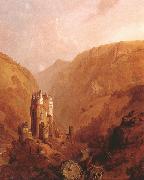 |
Clarkson Frederick Stanfield -- Click Here
|
|
English Painter, 1793-1867
He is often wrongly referred to as William Clarkson Stanfield. The son of Mary Hoad and James Field Stanfield, an Irish actor and author, he was apprenticed to a heraldic coach painter at the age of 12, but in 1808 he abandoned this and went to sea in a collier. In 1812 he was press-ganged and spent two years on HMS Namur, the guard-ship at Sheerness. After being discharged as the result of an injury in 1814, he joined the merchant navy, sailing to China in the Indiaman Warley in 1815. Soon after his return in 1816 he missed his ship and became a scene painter, first at the Royalty Theatre, Stepney, and then at the Royal Coburg, Lambeth. There he was later joined by David Roberts, who became a lifelong friend, and in 1822 both men were employed as scene painters at the Theatre Royal, Drury Lane. During the next 12 years Stanfield established himself as the most talented scene painter of his day, causing a sensation with some of his huge moving dioramas such as the scenes of Venice in the pantomine Harlequin and Little Thumb (1831). Meanwhile he was building an equally impressive reputation as an easel painter. He first exhibited at the Royal Academy in 1820 and continued to exhibit there regularly until his death. He was elected ARA in 1832 and RA in 1835. |
|
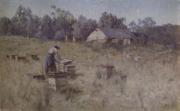 |
Clara Southern -- Click Here
|
|
Australian artist, 1860-1940
Australian painter. One of the first generation of progressive, professionally educated Australian women artists, she began her training as a pupil of Mme Mouchette, painter, schoolmistress and founder of the Alliance Fran?aise in Melbourne; and later took lessons from Walter Withers. As a student at the National Gallery of Victoria (1883-7) she was nicknamed 'Panther' for her lithe beauty. From mid-1888 she shared a teaching studio with Jane Sutherland in the new purpose-built Grosvenor Chambers, where Tom Roberts was a neighbour. She had 'caught the "Impressionist" fever', reported Table Talk (2 Aug 1889), and showed 'a great variety of charming little sketches, which however are not intended for exhibition'. She showed with the Victorian Artists' Society (1889-1917): mainly subjects around Kyneton and Melbourne's outer suburbs, painted in the fresh, quasi-Impressionist style characteristic of the Heidelberg school. |
|
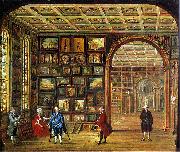 |
Christian Stocklin -- Click Here
|
|
Christian Stöcklin
Germany (Geneve 1741 -Frankfurt 1795 ) - Painter
|
|
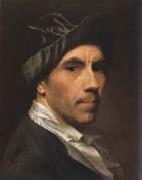 |
Christian Seybold -- Click Here
|
|
1690/7-1768
German painter, active in Austria. He went to Vienna in his youth and, apparently self-taught (Hagedorn), became a portrait-painter. His earliest known work, surviving only in an engraving (1728) by Andreas Schmutzer (1700-40) and Josef Schmutzer, is a portrait of Graf Johann Adam Questenberg in the formal Baroque style. Subsequently, under the influence of Balthasar Denner, he turned to a more intimate style of representation, |
|
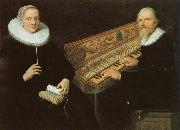 |
christian schubart -- Click Here
|
|
German poet,writer on music and composer. A distinguished keyboard player, he served at the Werttemberg court, 1769-73, then worked in Augsburg and Ulm. After imprisonment, 1777-87 (for insulting a duke's mistress), he became court and theatre poet at Stuttgart. As a composer he was best known for his lieder. His writings, including an important work on musical aesthetics (1806) and essays in his own periodical, stress expression in music. His poetry was often set; Schubert's four settings include Die Forelle and An meine Klavier.
|
|
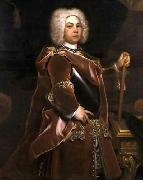 |
Christian Schilbach -- Click Here
|
|
( -1742 ) - Painter |
|
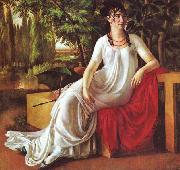 |
Christian Gottlieb Schick -- Click Here
|
|
painted Porträt Frau von Cotta in 1802 |
|
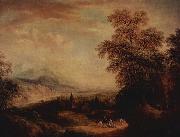 |
Christian Georg Schutz the Elder -- Click Here
|
|
painted Gebirgslandschaft in 1773 |
|
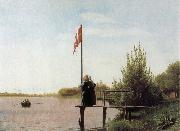 |
Christen Schjellerup Kobke -- Click Here
|
|
the most internationally renowned Danish painter .
Danish,1810-1848
|
|
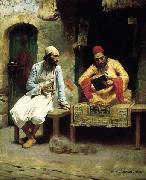 |
Charles Sprague Pearce -- Click Here
|
|
For other people named Charles Pearce, see Charles Pearce (disambiguation).
Charles Sprague Pearce (October 13, 1851 - May 18, 1914) was an American artist.
|
|
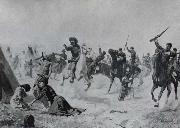 |
Charles Schreyvogel -- Click Here
|
|
American Painter, 1861-1912,was a painter of Western subject matter in the days of the disappearing frontier. Schreyvogel was especially interested in military life. He spent most of his life as an impoverished artist. He suddenly became recognized and earned what seemed like overnight fame. He was born in New York City. He also spent much of his childhood in Hoboken, New Jersey. He grew up in a poor family of German immigrant shopkeepers on the Lower East Side of New York. Schreyvogel was unable to afford art classes and he taught himself to draw. In 1901, he was awarded the Thomas Clarke Prize at the annual exhibition of the National Academy of Design. Schreyvogel did much of his work in his studio (or its rooftop) in decidedly non-Western Hoboken. |
|
|
|
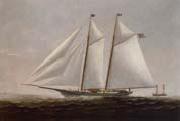 |
Charles S.Raleigh -- Click Here
|
|
English-born American, 1830-1925 |
|
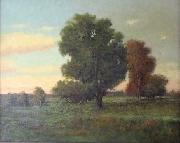 |
Charles S. Dorion -- Click Here
|
|
Charles was most likely born in Quebec, Canada, and moved to New York City sometime after 1880. He had a publishing company called C.S. Dorion, and was the 8th company to publish Edgar Allan Poe's the Raven, in New York in 1881.
PoliticsDuring the 1890s, Charles Dorian socialized with New York City's Social Democratic Party's elite, and used his quick tongue and self appointed crusading against injustice to help propel his friends political careers.
His first noted case was in the summer of 1893, when bucket shops were becoming a rampant problem in the city, as these "bucket shops" specializing in stocks and commodity futures, as the terms of trade were different for each bucket shop. |
|
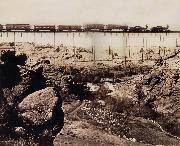 |
Charles Roscoe Savage -- Click Here
|
|
1832-1909, He was a British-born landscape and portrait photographer who produced images of the American West. He is best known for his 1869 photographs of the linking of the first transcontinental railroad. Savage was born in Southampton, England, on August 16, 1832. At age 14, he joined The Church of Jesus Christ of Latter-day Saints (LDS Church). After serving missions for the church in Switzerland and England, he emigrated to the United States during the winter of 1855?C56. He initially found work as a photographer in New York City, and headed west the following year. He first settled in Nebraska, then Council Bluffs, Iowa, where he established his first independent studio and gallery. In the spring of 1860, he traveled to Salt Lake City, Utah Territory with his family, where he established a photography studio with a partner, Marsena Cannon, an early Utah daguerreotypist and photographer. A year later, after Cannon moved to southern Utah, Savage established a partnership with artist George Ottinger. Many of Savage's photographs were reproduced in Harper's Weekly newspaper, which created a national reputation for the firm. This partnership continued until 1870. As a photographer under contract with the Union Pacific Railroad, Savage traveled to California in 1866 and then followed the rails back to Utah. He photographed the linking of the Union Pacific and Central Pacific on Promontory Summit, at Promontory, Utah in 1869 |
|
|
|
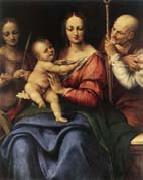 |
Cesare da Sesto -- Click Here
|
|
Italian High Renaissance Painter, 1477-1523, He was an Italian painter of the Renaissance active in Milan and elsewhere in Italy. He was born in Sesto Calende, Lombardy. He is considered one of the Leonardeschi or artists influenced by Leonardo da Vinci, such as Bernardino Luini and Marco D'Oggione. He may have trained or worked with Baldassare Peruzzi in Rome in 1505. Of this period, a lunette in Sant'Onofrio and some paintings in Campagnano Romano are attributed to him. From 1514 he soujourned in Naples for six years. In 1515 he finished a monumental polyptych for the Abbey of Santissima Trinita at Cava de' Tirreni. Back in Milan, he executed a Baptism of Christ, in collaboration with Bernardino Bernazzano (now lost) and a Salome, acquired by Rudolf II and now at the Kunsthistorisches Museum of Vienna. |
|
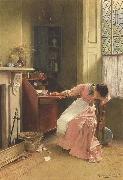 |
Carlton Alfred Smith,RI,RWS -- Click Here
|
|
fl.1871-1916
|
|
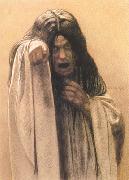 |
Carlos Schwabe -- Click Here
|
|
German Symbolist Painter, 1877-1926
Swiss painter and printmaker of German birth. He became a Swiss citizen and received his artistic training under Joseph Mittey (b 1853) at the Ecole des Arts Decoratifs in Geneva. Following brief success there, Schwabe moved to Paris where he supported himself as a designer of wallpaper while he developed considerable graphic skills. He soon became active in Symbolist circles, winning favour as an illustrator of mystical religious themes. His highly refined drawings and watercolours accompany texts such as Le Reve by Emile Zola (published 1892; drawings, Paris, Pompidou; exhibited Sociot Nationale des Beaux-Arts, also in 1892), Baudelaire's Les Fleurs du mal (1900), Maeterlinck's Pellias et Melisande, Catulle Mendes's L'Evangile de l'enfance de notre Seigneur Jesus-Christ selon Saint Pierre (1900) and Albert Samain's Jardin de l'Infante (1908). |
|
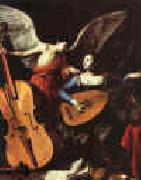 |
Carlo Saraceni -- Click Here
|
|
1580-1620
Italian
Carlo Saraceni Galleries
Carlo Saraceni (Venice 1579-Venice, 16 June 1620) was an Italian early-Baroque painter, whose reputation as a "first-class painter of the second rank" was improved with the publication of a modern monograph in 1968.
Though he was born in Venice, his paintings are distinctly Roman in style; he moved to Rome in 1598, joining the Accademia di San Luca in 1607. He never visited France, though he spoke fluent French and had French followers and a French wardrobe. His painting, however, was influenced at first by the densely forested, luxuriantly enveloping landscape settings for human figures of Adam Elsheimer, a German painter resident in Rome; "there are few landscapes by Saraceni which have not been attributed to Elsheimer," Malcolm Waddingham observed, and Anna Ottani Cavina has suggested the influences may have travelled both ways. and Elsheimer's small cabinet paintings on copper offered a format that Saraceni employed in six landscape panels illustrating The Flight of Icarus; in Moses and the Daughters of Jethro and Mars and Venus.
Saint Sebastian
Castle Museum, PragueWhen Caravaggio's notorious Death of the Virgin was rejected in 1606 as an altarpiece suitable for a chapel of Santa Maria della Scala, it was Saraceni who provided the acceptable substitute, which remains in situ, the only securely dated painting of his first decade in Rome. He was influenced by Caravaggio's dramatic lighting, monumental figures, naturalistic detail, and momentary action (illustration, right), so that he is numbered among the first of the "tenebrists" or "Caravaggisti". Examples of this style can be seen in the candlelit Judith and the Head of Holofernes.
Saraceni's matured rapidly between 1606 and 1610, and the next decade gave way to his fully mature works, synthesizing Caravaggio and the Venetians. In 1616?C17 he collaborated on the frescoes for the Sala Regia of the Palazzo del Quirinale. In 1618 he received payment for two paintings in the church of Santa Maria dell'Anima. The compositional details of his fresco of The Birth of the Virgin in the Chapel of the Annunciation of the church of Santa Maria in Aquiro are repeated in a panel on copper at the Louvre
In 1620 he returned to Venice, where he died in the same year. He was so influential on the style of an anonymous still life painter working in Rome, that the man is known as "Pensionante del Saraceni" |
|
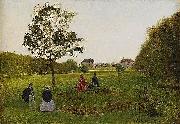 |
Carl Stefan Bennet -- Click Here
|
|
Carl Stefan Bennet (1800-1878) was a Swedish painter |
|
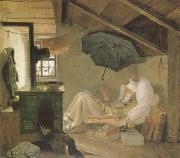 |
Carl Spitzweg -- Click Here
|
|
German Painter, 1808-1885
German painter. He trained (1825-8), at his father's insistence, as a pharmacist, by 1829 becoming manager of a pharmacy in the Straubing district of Munich. From 1830 to 1832 he made advanced studies in pharmacy, botany and chemistry at the University of Munich, passing his final examination with distinction. On receiving a large legacy in 1833, which made him financially independent, he decided to become a painter. He had drawn since the age of 15 and had frequented artistic circles since the late 1820s; but he had no professional training as a painter. He learnt much from contacts with young Munich landscape painters such as Eduard Schleich the elder and produced his first oil paintings in 1834. In 1835 he became a member of the Munich Kunstverein but left two years later due to disappointment over the reception of the first version of the Poor Poet (1837; Munich, Neue Pin.; second version 1839; Berlin, Neue N.G.), a scene of gently humorous pathos that has since become his most celebrated work. Spitzweg's decision to leave the Kunstverein, however, was also encouraged by his first successful attempts to sell his paintings independently. In 1839 he travelled to Dalmatia, where he made sketches that he used for many later works on Turkish themes (e.g. the Turkish Coffee House, c. 1860; Munich, Schack-Gal.). From the 1840s he travelled regularly, usually with his close friend, the painter Schleich, both within Bavaria and to Austria and Switzerland and also to the Adriatic coast, especially to Trieste. |
|
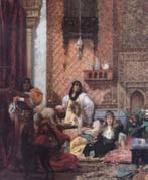 |
Carl Schweninger -- Click Here
|
|
a genre, Animal and Landscape painter.
Austrian,1818-1887 |
|
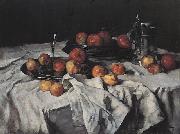 |
Carl Schuch -- Click Here
|
|
(30 September 1846 - 13 September 1903) was an Austrian painter, born in Vienna, who spent most of his lifetime outside Austria, in Germany, Italy and France. He painted primarily still lifes and landscapes.
During the period 1882-94 he was based in Paris, where he was greatly impressed by the work of Claude Monet whom he described as "the Rembrandt of plein-air painting" although he was attracted most of all to Rembrandt and the artists of the Barbizon school. In 1884 and 1885 he spent the summer months in the Netherlands, studying the Dutch old masters as well as the contemporary painters of the Hague School, and filling notebooks with detailed descriptions of the colors he observed in paintings that he admired. Of all the artists belonging to the circle around Wilhelm Leibl (called the Leibl-Kreis), Schuch was the most devoted to color. His work marks the transition from the realist tradition to the modern movement in Vienna, esthetically, however, it is far from contemporary trends, and from its means and ends, comparable to Paul Cezanne (Gottfried Boehm, referring to Arnold Gehlen). |
|
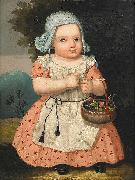 |
Carl Johan Sjostrand -- Click Here
|
|
(1789 -1857 ) - Painter
|
|
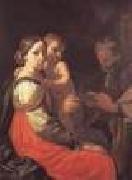 |
CANTARINI, Simone -- Click Here
|
|
Italian painter, Bolognese school (b. 1612, Pesaro, d. 1648, Pesaro)
Simone Cantarini (also known as Simone da Pesaro; 12 April 1612 - 1648) was an Italian painter and etcher of the Bolognese School of painting.
Cantarini was born in Oropezza near Pesaro, then part of the Papal States.
Initially he was a pupil of the Venetian Claudio Ridolfi and Pesarese Giovanni Giacomo Pandolfi, and then, for about 4 years (1635-1639), of Guido Reni. He soon fought with his mentor, and did not return to Bologna till after Reni had died (1642). His pictures are generally derivative. Some of his works have been mistaken for examples of Reni. Among his principal paintings are St. Anthony, at Cagli; the Magdalene, at Pesaro; the Transfiguration in the Brera Gallery, Milan; the Portrait of Guido, in the Bologna gallery; and St. Romuald, in the Casa Paolucci. His most celebrated etching is Jupiter, Neptune and Pluto, honoring the heraldic arms of Cardinal Borghese. |
|
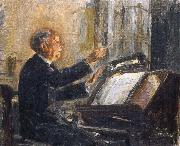 |
camille saint -- Click Here
|
|
Period: Post-Romantic (1870-1909)
Country: France
Born: October 09, 1835 in Paris, France
Died: December 16, 1921 in Algiers, Algeria
Genres: Chamber Music, Choral Music, Concerto, Keyboard Music, Miscellaneous Music, Opera, Orchestral Music, Symphony
|
|
 |
Burne-Jones, Sir Edward Coley -- Click Here
|
|
British Pre-Raphaelite Painter, 1833-1898
English painter and decorative artist. He was the leading figure in the second phase of the Pre-Raphaelite movement. His paintings of subjects from medieval legend and Classical mythology and his designs for stained glass, tapestry and many other media played an important part in the Aesthetic Movement and the history of international Symbolism. |
|
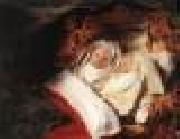 |
BRAY, Salomon de -- Click Here
|
|
Dutch Baroque Era Painter, 1597-1664
De Bray established himself in Haarlem before 1617, where he is supposed to have been taught by Hendrick Goltzius and Cornelis van Haarlem, and where he married in 1625. He painted history paintings, portraits and landscapes. As a Catholic he probably also made altar pieces for clandestine churches. He cooperated in the decoration of Huis ten Bosch in The Hague. His works draw on the spirit of the Dutch classicism beginning at that time, and are comparable with those of Pieter de Grebber.
De Bray was also active as a designer of silverwork, as a poet, as an architect and as a town planner. As an architect, he was involved in the construction or expansion of Haarlem's City Hall, Zijlpoort, and St. Annakerk (Church of St. Anne), and Nijmegen's city orphanage. One of his poems was set to music by his friend the composer Cornelis Padbru??.
Salomon de Bray was the father of ten children, of whom three (including Jan de Bray) became artists. He probably died of the plague, as some of his children and was buried in the Sint-Bavokerk in Haarlem. |
|
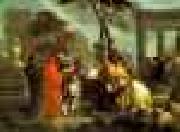 |
Bourdon, Sebastien -- Click Here
|
|
French, 1616-1671.French painter. Bourdon was active in Rome (1634 C37), in Sweden (1652 C54) as Queen Christina's court portrait painter, and in Paris; he also worked in his native Montpellier, where he painted The Fall of Simon Magus for the cathedral. The Finding of Moses is in the National Gallery of Art, Washington, D.C. |
|
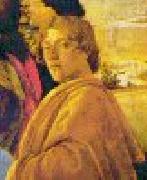 |
BOTTICELLI, Sandro -- Click Here
|
|
Italian Early Renaissance Painter, 1445-1510
Alessandro di Mariano di Vanni Filipepi, better known as Sandro Botticelli or Il Botticello ("The Little Barrel"; March 1, 1445 ?C May 17, 1510) was an Italian painter of the Florentine school during the Early Renaissance (Quattrocento). Less than a hundred years later, this movement, under the patronage of Lorenzo de' Medici, was characterized by Giorgio Vasari as a "golden age", a thought, suitably enough, he expressed at the head of his Vita of Botticelli. His posthumous reputation suffered until the late 19th century; since then his work has been seen to represent the linear grace of Early Renaissance painting, and The Birth of Venus and Primavera rank now among the most familiar masterpieces of Florentine art.
Details of Botticelli's life are sparse, but we know that he became an apprentice when he was about fourteen years old, which would indicate that he received a fuller education than did other Renaissance artists. Vasari reported that he was initially trained as a goldsmith by his brother Antonio. Probably by 1462 he was apprenticed to Fra Filippo Lippi; many of his early works have been attributed to the elder master, and attributions continue to be uncertain. Influenced also by the monumentality of Masaccio's painting, it was from Lippi that Botticelli learned a more intimate and detailed manner. As recently discovered, during this time, Botticelli could have traveled to Hungary, participating in the creation of a fresco in Esztergom, ordered in the workshop of Fra Filippo Lippi by Vitez J??nos, then archbishop of Hungary.
By 1470 Botticelli had his own workshop. Even at this early date his work was characterized by a conception of the figure as if seen in low relief, drawn with clear contours, and minimizing strong contrasts of light and shadow which would indicate fully modeled forms. |
|
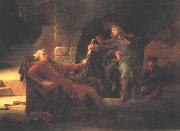 |
Bertalan Szekely -- Click Here
|
|
(May 8, 1835 - August 21, 1910) was a Hungarian Romantic painter of historical themes. "The Discovery of Louis II's Dead Body", "Women of Eger", "Battle of Mohe - s", "Ladislas V" are among the most important of his historical paintings. Szekely is also known for his many murals.
|
|
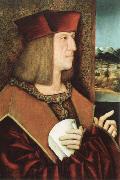 |
bernhard strigel -- Click Here
|
|
Bernhard Strigel (c. 1461 ?C 1528) was a German portrait and historical painter of the Swabian school, the most important of a family of artists established at Memmingen. He was born at Memmingen and was probably a pupil of Zeitblom at Ulm. He stood in high favor with the Emperor Maximilian I, in whose service he repeatedly journeyed to Augsburg, Innsbruck, and Vienna. |
|
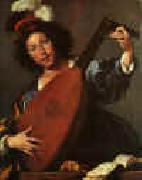 |
Bernardo Strozzi -- Click Here
|
|
1581-1644
Italian
Bernardo Strozzi Galleries
Strozzi was born in Genoa. He was probably not related to the other Strozzi family.
In 1598, at the age of 17, he joined a Capuchin monastery, a reform branch of the Franciscan order. When his father died c1608, he left the order to care for his mother, earning their living with his paintings, which were often influenced by Franciscan teachings, for example his Adoration of the Shepherds (c. 1615) . In 1625, he was charged with illegally practicing as a painter. When his mother died c1630, Bernardo was pressured in court by the Capuchin's to re-enter the order. He was briefly imprisoned in Genoa , and upon release fled to Venice to avoid confinement in a monastery in 1631. He became nicknamed all his life as il prete Genovese (the Genoa priest).
Saint Christopher, by Strozzi.Early paintings, such as The Ecstasy of St Francis show the dark emotionalism of Caravaggio. But by the second decade of the 17th century, while working in Venice, Strozzi had synthesized a personal style which fused painterly influences of the North (including Rubens and Veronese) with a monumental realistic starkness. For example, in the painting The Incredulity of Thomas, the background is muted, yet Jesus' face, haloed and his outline, misty, in a style atypical of Caravaggio. Never as dark as the Caravaggisti, Venice infused his painting with a gentler edge, a style more acceptable to the local patronage, and one derived from his precursors in Venice, Jan Lys (died 1629) and Domenico Fetti (died 1626), who had also fused the influence of Caravaggio into Venetian art. Examples of this style can be found in his Parable of the Wedding Guests (1630),Christ giving keys of Heaven to Saint Peter (1630),, Saint Lawrence distributing Alms at San Nicol?? da Tolentino[7] and a Personification of Fame (1635-6). He was also likely influenced by Velazquez (who visited Genoa in 1629-30).
After a commission to paint Claudio Monteverdi his fame grew, and his portrait paintings included many of the leading Venetians. His pupils and painter strongly influenced by him included Giovanni Andrea de Ferrari (1598-1669), Giovanni Bernardo Carbone, Valerio Castello and, Giovanni Benedetto Castiglione. |
|
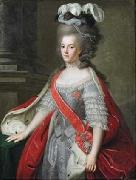 |
Benjamin Samuel Bolomey -- Click Here
|
|
painted Portrait of Wilhelmina of Prussia (1751-1820), Princess of Orange in 18th century
|
|
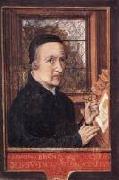 |
BENING, Simon -- Click Here
|
|
Flemish Northern Renaissance Manuscript Illuminator, ca.1483-1561
Simon Bening (1483?C1561) was a 16th century miniature painter of the Ghent-Bruges school, the last major artist of the Netherlandish tradition.
Bening was trained in his father Alexander Bening's miniature painting workshop in Ghent. He made his own name after moving to Bruges. His specialty was the book of hours, but by his time these were becoming relatively unfashionable, and only produced for royalty and the very rich. He also created genealogical tables and portable altarpieces on parchment. Many of his finest works are Labours of the Months for Books of Hours which are largely small scale landscapes, at that time a nascent genre of painting. In other respects his style is relatively little developed beyond that of the years before his birth, but his landscapes serve as a link between the 15th century illuminators and Peter Brueghel. His self-portrait and other portraits equally are early examples of the portrait miniature. He served as dean of the calligraphers, booksellers, illuminators, and bookbinders in the Guild of Saint John and Saint Luke.
He created books for German rulers, like Cardinal Albrecht of Brandenburg, and royalty like Emperor Charles V and Don Fernando, the Infante of Portugal.
The artistic tradition continued in his family. His eldest daughter, Levina Teerlinc, became a miniature painter, mostly of portrait miniatures and another daughter became a dealer in paintings, miniatures, parchment, and silk. |
|
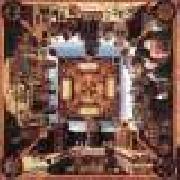 |
BEHAM, Hans Sebald -- Click Here
|
|
German Northern Renaissance Engraver, 1500-1550
Hans Sebald Beham (1500 ?C 1550) was a German printmaker who did his best work as an engraver, and was also a designer of woodcuts and a painter and miniaturist. He is one of the most important of the "Little Masters", the group of German artists making old master prints in the generation after Durer.
Beham is best known as a prolific printmaker, producing approximately 252 engravings, 18 etchings and 1500 woodcuts, including woodcut book illustrations. He worked extensively on tiny, highly detailed, engravings, many as small as postage stamps, placing him in the German printmaking school known as the "Little Masters" from the size of their prints. These works he produced and published himself, whilst his much larger woodcuts were mostly commissioned work. The engravings found a ready market among German bourgeois collectors, but were not much seen in Italy. He also made prints for use as playing cards, wallpaper, coats of arms, and designs for other artists, including many designs for stained or painted glass. He also illuminated two prayer books and painted a table top (now in the Louvre ) for Cardinal Albrecht, Archbishop of Mainz. |
|
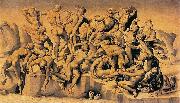 |
Bastiano da Sangallo -- Click Here
|
|
(1481 - May 31, 1551) was an Italian sculptor and painter of the Renaissance period, active mainly in Tuscany. He was a nephew of Giuliano da Sangallo and Antonio da Sangallo the Elder. He is usually known as Aristotile, a nickname he received from his air of sententious gravity. He was at first a pupil of Perugino, but afterwards became a follower of Michelangelo. Mentioned by Vasari as one who made a small copy of the Cartoon of Michelangelo Battle of Cascina (1506).
|
|
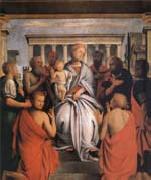 |
Bartolomeo Suardi -- Click Here
|
|
c. 1465?C1530,was an Italian painter and architect, mainly active in his native Milan. He was born in Milan, the son of Alberto Suardi, but his biography remains unclear, and was long complicated by two "Pseudo-Bramantinos". He was trained by Donato Bramante, adopting a diminutive form of his master's name. This training gave him influences from by the Urbino quattrocento tradition of immobile realism, and later he assimilated some elements of the style of Leonardo, after he arrived in Milan, although in other respects he remained faithful to his training in the style of Central Italy. He is documented in late 1508 as helping in the decoration of the Vatican Stanze though nothing remains of his work there, and by 1509 he was back in Milan. His style changed considerably during his career, and also shows strongly individual traits. His main influences were the serene and sometimes unnatural quietist classicism of Piero della Francesca, Leonardo da Vinci, and Ercole de' Roberti |
|
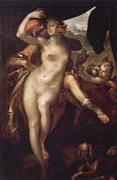 |
Bartolomeo Spranger -- Click Here
|
|
Belgium
1546-1611 |
|
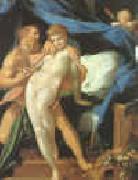 |
Bartholomeus Spranger -- Click Here
|
|
1546-1611
Flemish
Bartholomeus Spranger Gallery
Bartholomeus (Bartholomaeus) Spranger (21 March 1546??August 1611) was a Flemish Mannerist painter, draughtsman, and etcher. He was born in Antwerp.
In 1565, he traveled to Paris and Italy after finishing his studies. He worked on wall paintings in various churches. At Rome, Pope Pius V appointed him court painter in 1570. In 1581 he was appointed to the Prague court of Rudolf II, Holy Roman Emperor.
Hendrik Goltzius made engravings of his paintings, thus increasing Spranger's fame. Spranger's Mannerist paintings depict nudes in various complex poses.
He died in Prague. |
|
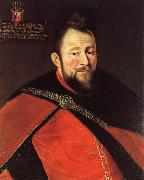 |
Bartholomaus Strobel -- Click Here
|
|
(Breslau 1591-1647 Thorn) was a German baroque painter from Silesia who worked in Poland.
He studied art in the studio of his father. He spent time in Vienna and in Prague. In 1633 he settled in Gdansk and in 1637 operated in Elbing, and thereafter in Torun.
According to Houbraken he received the Dutch painter Gillis Schagen in Elbing in 1637. Strobel was court painter to the emperor at that time, and later became court painter to Władysław IV Vasa, King of Poland.Schagen painted a portrait of the King of Poland to "prove his mastership of the art" for him.
According to the RKD he worked mostly in Prague.
He produced royal court paintings and paintings for the chapel of St.. Kaźmirza in Vilna, (1636-37), and religious paintings in Torue in 1634.
|
|
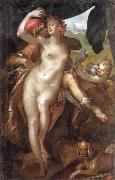 |
Bartholomaus Spranger -- Click Here
|
|
Antwerp 1546-Prague 1611
|
|
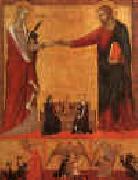 |
Barna da Siena -- Click Here
|
|
Italian Painter, active ca.1350
Barna da Siena, also known as Barna di Siena, was a Sienese painter active from about 1330 to 1350, and was the painter in Siena during this period. He learned his trade from Simone Martini. Barna is believed to have paint the frescoes depicting the life of Jesus in the Collegiata di San Gimignano and is generally credited with Christ Bearing the Cross, with a Dominican Friar in the Frick Collection in New York City. He was killed in a fall from the scaffolding. Barna's figures are more dramatic and vigorous than any in previous Sienese painting. |
|
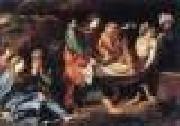 |
BADALOCCHIO, Sisto -- Click Here
|
|
Italian Baroque Era Painter, 1585-ca.1619
Italian painter and etcher. His formation as an artist took place within the Carracci circle. According to Malvasia, he may have attended the Carracci Academy in Bologna, before returning to Parma in 1600 as the pupil of Agostino Carracci when the latter entered the service of Ranuccio I Farnese, 4th Duke of Parma. After Agostino's death in 1602, Badalocchio and his fellow pupil Giovanni Lanfranco were sent by the Duke to Rome in order to complete their training in the studio of Annibale Carracci, who was then working in the Palazzo Farnese. Badalocchio remained with Annibale until the latter's death in 1609. He participated in most of the projects that occupied the studio assistants during those years, such as the frescoes on the walls of the Galleria in the Palazzo Farnese and those previously in the Herrera Chapel in S Maria di Monserrato, Rome (now detached and divided between Madrid, Prado, and Barcelona, Mus. A. Catalunya), although his precise share in them is still debated. His first signed works are etchings, one (1606) after the antique sculpture of the Laokoon (Rome, Vatican, Mus. Pio-Clementino) and 23 (1607, part of a series of 54 executed in collaboration with Lanfranco) after Raphael's frescoes in the Vatican Logge; they reveal the romanizing character of his training. Yet his independent paintings of this early period reveal the influence of Lanfranco, which was to last throughout his career; the lively play of light and shade suggests his allegiance to Emilian art.
|
|
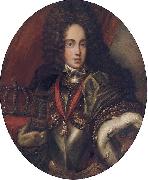 |
Austrian School -- Click Here
|
|
painted Future Emperor Charles VI in before 1711
|
|
|
|
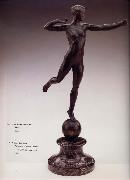 |
Augustus Saint-Gaudens -- Click Here
|
|
Irish-born American Realist Sculptor, 1848-1907, He was the Irish-born American sculptor of the Beaux-Arts generation who most embodied the ideals of the "American Renaissance." Raised in New York City, he traveled to Europe for further training and artistic study, and then returned to major critical success in the design of monuments commemorating heroes of the American Civil War, many of which still stand. In addition to his famous works such as the Robert Gould Shaw Memorial on Boston Common and the outstanding grand equestrian monuments to Civil War generals John A. Logan, atop a tumulus in Chicago, 1894-97 |
|
 |
August Strindberg -- Click Here
|
|
1849-1912
Swedish painter, sculptor and playwright. He had no art training, but learnt from artist friends after abandoning his studies at the University of Uppsala in 1872. The chief influence on him was Per Ekström, whose broken colour-spot technique he attempted to copy during his initial painting period in 1872-4 in Stockholm and on the skerry-islands Kymmendö and Sandhamn. Very little of Strindberg's early painting survives, but he had already found his special motifs: the sea, usually with turbulent waves; solitary trees or flowers on bare cliffs or sandy beaches in the outermost fringe of the skerries. After he stopped painting in 1874 he became Sweden's leading art critic, as well as the ideological leader of the radical Swedish artists' movement, which in 1884 formed the Konstnärsförbund (the Artists' Association) in protest against the Academy of Art. Prominent among the members were the painters Carl Olof Larsson, Karl Nordström and Richard Bergh. During this period, however, he produced sketches in words and pictures as illustrations to his own writings, which Carl Larsson was commissioned to do thereafter. From 1883 he stayed abroad, primarily in France and Switzerland, and belonged during a couple of long periods to the Scandinavian artists' colony in Grez-sur-Loing, near Fontainebleau in France. In 1886 in Switzerland he started photography and took a series of self-portraits that were intended for publication |
|
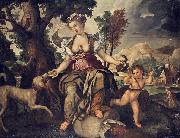 |
Augsburger Schule -- Click Here
|
|
painted Allegory of Remorselessness in between 1580(1580) and 1600(1600)
|
|
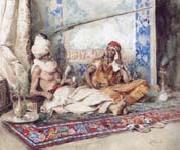 |
Attilio Simonetti -- Click Here
|
|
Italian, 1843-1925 |
|
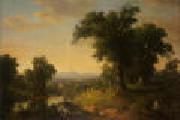 |
Asher Brown Durand -- Click Here
|
|
1796-1886
Asher Brown Durand Galleries
His interest shifted from engraving to oil painting around 1830 with the encouragement of his patron, Luman Reed. In 1837, he accompanied his friend Thomas Cole on a sketching expedition to Schroon Lake in the Adirondacks and soon after he began to concentrate on landscape painting. He spent summers sketching in the Catskills, Adirondacks, and the White Mountains of New Hampshire, making hundreds of drawings and oil sketches that were later incorporated into finished academy pieces which helped to define the Hudson River School.
Durand is particularly remembered for his detailed portrayals of trees, rocks, and foliage. He was an advocate for drawing directly from nature with as much realism as possible. Durand wrote, "Let [the artist] scrupulously accept whatever [nature] presents him until he shall, in a degree, have become intimate with her infinity...never let him profane her sacredness by a willful departure from truth."
Like other Hudson River School artists, Durand also believed that nature was an ineffable manifestation of God. He expressed this sentiment and his general views on art in his "Letters on Landscape Painting" in The Crayon, a mid-19th century New York art periodical. Wrote Durand, "[T]he true province of Landscape Art is the representation of the work of God in the visible creation..."
Durand is noted for his 1849 painting Kindred Spirits which shows fellow Hudson River School artist Thomas Cole and poet William Cullen Bryant in a Catskills landscape. This was painted as a tribute to Cole upon his death in 1848. The painting, donated by Bryant's daughter Julia to the New York Public Library in 1904, was sold by the library through Sotheby's at an auction in May 2005 to Alice Walton for a purported $35 million. The sale was conducted as a sealed, first bid auction, so the actual sales price is not known. At $35 million, however, it would be a record price paid for an American painting at the time. |
|
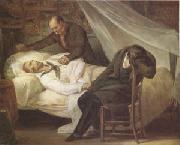 |
Ary Scheffer -- Click Here
|
|
Dordrecht 1795-Argenteuil 1858
Dutch painter, sculptor and lithographer, active in France. He became a French citizen in 1850. He received his earliest training in the studio of his parents, Johann-Bernhard Scheffer (1764-1809) and Cornelia Scheffer (1769-1839), who were both artists, as was his brother Henri Scheffer (1798-1862). He then attended the Amsterdam Teeken-Academie (1806-9). At the first Exhibition of Living Masters in Amsterdam in 1808 he showed Hannibal Swearing to Avenge the Death of his Brother Hasdrubal |
|
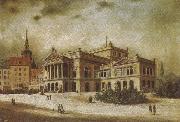 |
arthur o shaughnessy -- Click Here
|
|
1844 C 81, English poet and naturalist. He was a member of the zoological department of the British Museum. He wrote four volumes of poetrye Epic of Women (1870), Lays of France (1872), Music and Moonlight (1874), and Songs of a Worker (1881)??which all reveal the influence of D. G. Rossetti. One ode, beginning, We are the music-makers, is his best-known poem. |
|
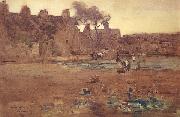 |
Arthur Melville,ARSA,RSW,RWS -- Click Here
|
|
1855-1904 |
|
|
|
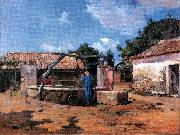 |
Antonio Carvalho de Silva Porto -- Click Here
|
|
(Porto, 11 November 1850 - Porto, 11 June 1893) was a Portuguese naturalist painter.
Born in Porto, he studied there under João Antenio Correia and T. Furtado, then continued his studies in Paris and Rome.
While in Paris he exhibited his work in the Salon and in the World´s Fair of 1878. In Paris, he studied with his friend João Marques de Oliveira, where they were pupils of Adolphe Yvon and Alexandre Cabanel. They became followers of the naturalist Barbizon School, and brought the new school of painting to Portugal, when they returned in 1879.
Silva Porto become one of the most acclaimed naturalist painters of his generation, showing the heritage of Jean-Baptiste Camille Corot and Charles-François Daubigny. Secondary effects from impressionism can sometimes be found in his paintings.
|
|
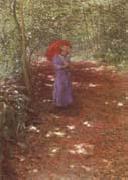 |
Antonin Slavicek -- Click Here
|
|
1870 - 1918
(1870?C1910) was a renowned Czech painter. He was a part of the Czech impressionist movement. One of his most famous works is Garden Wall, which hangs in the National Gallery in Prague.
|
|
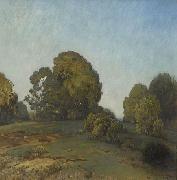 |
Anton Ritter von Stadler -- Click Here
|
|
painting Landschaft in 1909 |
|
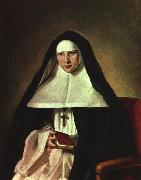 |
Antoine Sebastien Plamondon -- Click Here
|
|
1804-1895 Canadian Antoine Sebastien Plamondon Gallery |
|
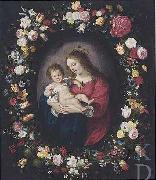 |
Antoine Sallaert -- Click Here
|
|
(1585-1650) was a Flemish Baroque painter.
According to Houbraken his work survived in Brussels, where he lived and died. He was sorry he could not find more data on this artist. According to the RKD he was registered in the Brussels Guild of Saint Luke as a master in 1613 and used the monograms ASall f and AS entwined. |
|
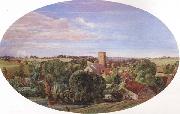 |
Anthony Frederick Augustus Sandys -- Click Here
|
|
1829-1904
English painter, illustrator and draughtsman. He was the son of Anthony Sands (1804-83), a minor local artist. He began his artistic education with his father and attended the Norwich School of Design from 1846. His precocious talent was recognized by the award of silver medals by the Society of Arts in 1846 and 1847. He moved to London in 1851, when he first exhibited at the Royal Academy, but he continued to spend time at Norwich until the death of his parents in 1883. After publishing in 1857 A Nightmare, a gentle caricature of John Ruskin and his Pre-Raphaelite prot?g?s William Holman Hunt, John Everett Millais and Dante Gabriel Rossetti and based on Millais's Sir Isumbras at the Ford (Port Sunlight, Lady Lever A.G.), he met Rossetti and became a member of his circle. |
|
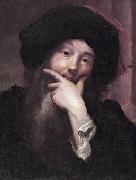 |
Anthoni Schoonjans -- Click Here
|
|
(1655 - 13 August 1726) was a Flemish painter.
He was born in Antwerp and became a pupil of Erasmus Quellinus II and his son Jan-Erasmus Quellinus. He travelled to Rome and like his teachers had done before him, joined the Bentvueghels with the nickname "Parrhasius" in 1674. In Rome he lived with Charles de Vogelaer in the via Margutta and later he lived from 1688-89 in the Corso, near the via di Ripetta. In 1695 he became court painter in Vienna, where he later died. During the course of his lengthy career he also worked in Antwerp, Riems, Lyon, Amsterdam, the Hague, Brno, Dusseldorf, Copenhagen, and Berlin.He is known for portraits and historical allegories, and was the teacher of Georg Gsell. |
|
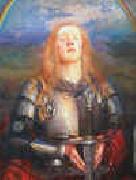 |
Annie Louise Swynnerton -- Click Here
|
|
British
1844-1933
|
|
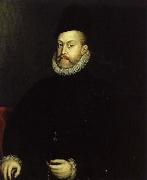 |
anguissola sofonisba -- Click Here
|
|
The best known of the sisters, she was trained, with Elena, by Campi and Gatti. Most of Vasari's account of his visit to the Anguissola family is devoted to Sofonisba, about whom he wrote: 'Anguissola has shown greater application and better grace than any other woman of our age in her endeavours at drawing; she has thus succeeded not only in drawing, colouring and painting from nature, and copying excellently from others, but by herself has created rare and very beautiful paintings'. Sofonisba's privileged background was unusual among woman artists of the 16th century, most of whom, like Lavinia Fontana (see FONTANA (ii),(2)), FEDE GALIZIA and Barbara Longhi (see LONGHI (i), (3)), were daughters of painters. Her social class did not, however, enable her to transcend the constraints of her sex. Without the possibility of studying anatomy, or drawing from life, she could not undertake the complex multi-figure compositions required for large-scale religious or history paintings. She turned instead to the models accessible to her, exploring a new type of portraiture with sitters in informal domestic settings. The influence of Campi, whose reputation was based on portraiture, is evident in her early works, such as the Self-portrait (Florence, Uffizi). Her work was allied to the worldly tradition of Cremona, much influenced by the art of Parma and Mantua, in which even religious works were imbued with extreme delicacy and charm. From Gatti she seems to have absorbed elements reminiscent of Correggio, beginning a trend that became marked in Cremonese painting of the late 16th century. This new direction is reflected in Lucia, Minerva and Europa Anguissola Playing Chess (1555; Poznan, N. Mus.) in which portraiture merges into a quasi-genre scene, a characteristic derived from Brescian models.
|
|
 |
ANGUISSOLA Sofonisba -- Click Here
|
|
Italian Mannerist Painter, 1532-1625
The best known of the sisters, she was trained, with Elena, by Campi and Gatti. Most of Vasari's account of his visit to the Anguissola family is devoted to Sofonisba, about whom he wrote: 'Anguissola has shown greater application and better grace than any other woman of our age in her endeavours at drawing; she has thus succeeded not only in drawing, colouring and painting from nature, and copying excellently from others, but by herself has created rare and very beautiful paintings'. Sofonisba's privileged background was unusual among woman artists of the 16th century, most of whom, like Lavinia Fontana (see FONTANA (ii),(2)), FEDE GALIZIA and Barbara Longhi (see LONGHI (i), (3)), were daughters of painters. Her social class did not, however, enable her to transcend the constraints of her sex. Without the possibility of studying anatomy, or drawing from life, she could not undertake the complex multi-figure compositions required for large-scale religious or history paintings. She turned instead to the models accessible to her, exploring a new type of portraiture with sitters in informal domestic settings. The influence of Campi, whose reputation was based on portraiture, is evident in her early works, such as the Self-portrait (Florence, Uffizi). Her work was allied to the worldly tradition of Cremona, much influenced by the art of Parma and Mantua, in which even religious works were imbued with extreme delicacy and charm. From Gatti she seems to have absorbed elements reminiscent of Correggio, beginning a trend that became marked in Cremonese painting of the late 16th century. This new direction is reflected in Lucia, Minerva and Europa Anguissola Playing Chess (1555; Poznan, N. Mus.) in which portraiture merges into a quasi-genre scene, a characteristic derived from Brescian models. |
|
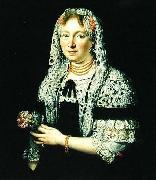 |
Andreas Stech -- Click Here
|
|
painted Portrait of a Patrician Lady from Gdansk in 1685 |
|
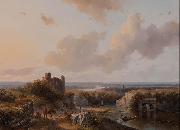 |
Andreas Schelfhout -- Click Here
|
|
(February 16, 1787, The Hague - April 19, 1870, The Hague) was a Dutch painter, etcher and lithographer, known for his landscape paintings.
He belongs to the Romantic movement. His Dutch winter scenes and frozen canals with skaters were already famous during his lifetime. He became one of the most influential Dutch landscape artists of his century.
He started as a house painter in the framing business of his father. He already started painting pictures in his spare time. After a well-received first exhibition in The Hague, his father sent him to receive proper training to Joannes Breckenheimer (1772-1856), a stage designer, in The Hague. He learned not only the technical aspects of painting, but also made detailed studies of the 17th-century Dutch landscape artists Meindert Hobbema en Jacob van Ruisdael.
In 1815 he started his own workshop. Through his technical excellence and sense of composition and his use of naturalistic colours, he soon became famous also outside The Hague. In 1819 he was awarded the Gold Medal at the exhibition in Antwerp. In 1818 he became a member of the Royal Academy for Visual Arts of Amsterdam. He reputation continued to grow and in1822 he was given the rank of Fourth Class Correspondent of the Royal Dutch Institute. From then on, one exhibition followed after another.
Initially he painted mainly summer scenes, beach scenes, and animal paintings. But as his initial winter scenes even had more success, he began to include them in his exhibitions. He was mainly a studio artist, relying on his sketches done en plein air. His sketchbook Liber Veritatis (Book of Truth) shows that he made about twenty paintings a year, among them a few foreign views. This indicated that he travelled abroad around 1825. In later years he visited France in 1833, England in 1835 (especially to study the works of Constable) and Germany.
He provided training to several painters who would become famous in their own right : Johan Hendrik Weissenbruch, Johan Jongkind (one of the forerunners of the Impressionists), Charles Leickert, Jan Willem van Borselen, Nicholas Roosenboom, Willem Troost, the American Hudson River School Painter Louis Remy Mignot and his son-in-law Wijnand Nuyen.
At the end of his career he put together a series of eighty landscape drawings, mainly recordings of previous paintings and watercolours. They were drawn in chalk and lightly coloured.
His death marked the end of the Romantic period in Holland. He is considered a precursor of the Hague School
|
|
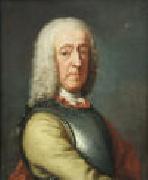 |
Andrea Soldi -- Click Here
|
|
Italian
C1703-1771
Italian painter. George Vertue, the only source for Soldi's earliest years, described him in 1738 as a Florentine aged 'about thirty-five or rather more' who had been in England 'about two years'. He had previously been in the Middle East, where he painted some British merchants of the Levant Company who had advised him to go to London. Two three-quarter-length portraits called Thomas Sheppard (1733 and 1735-6; ex-art market, London, 1917 and 1924, see Ingamells, 1974) belong to this period. In London Soldi enjoyed considerable success in the period between 1738 and 1744; Vertue reported that he began 'above thirty portraits' between April and August 1738. He was extensively patronized by the 2nd and 3rd Dukes of Manchester (eight portraits, sold Kimbolton Castle, Cambs, 18 July 1949), the 3rd Duke of Beaufort (four portraits at Badminton House, Glos) and the 4th Viscount Fauconberg (eight portraits at Newburgh Priory, N. Yorks). The seated three-quarter-length of Isabella, Duchess of Manchester, as Diana (1738; London, Colnaghi's, 1986) and the informal full-length of Lord Fauconberg (c. 1739; Newburgh Priory, N. Yorks) exemplify his lively handling, strong colour and theatrical, Italianate imagination. In a less extravagant vein, the Duncombe Family (1741; priv. col., see Ingamells, 1974), a conversation piece of some charm, and the Self-portrait (1743; York, C.A.G.) suggest a versatile talent. Soldi's bravura contrasted with contemporary English portrait practice, then wavering between the sober manner of Kneller and a playful Rococo, and his attraction for Italianate Englishmen was obvious. He was rivalled only by Jean-Baptiste van Loo, who was in London between 1737 and 1742; both artists painted the dealer Owen McSwiny and the poet Colley Cibber about 1738. He far outclassed his Italian rivals, the Cavaliere Rusca (1696-1769), who worked in London from 1738 to 1739, and Andrea Casali, who was in London from 1741 to 1766. |
|
|
|
|
| | |
|
|
|
|